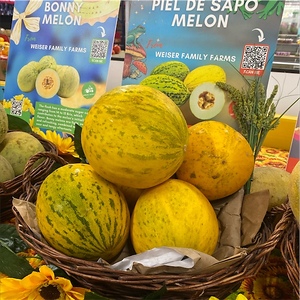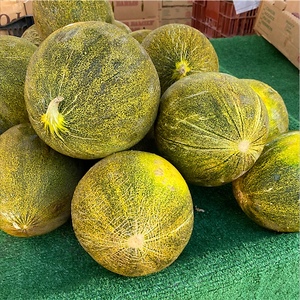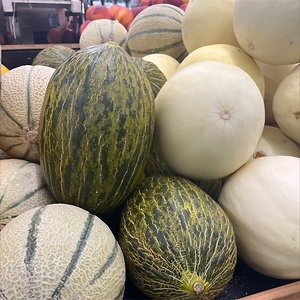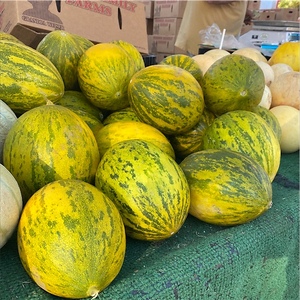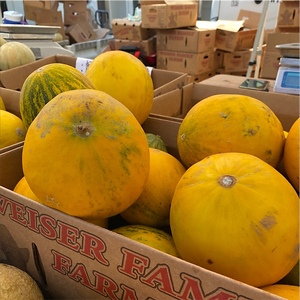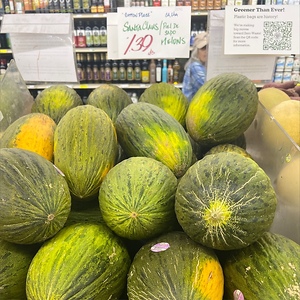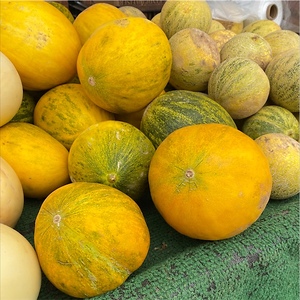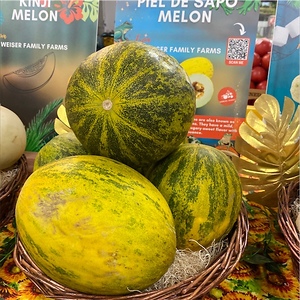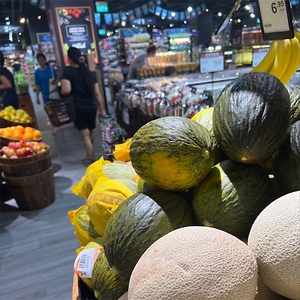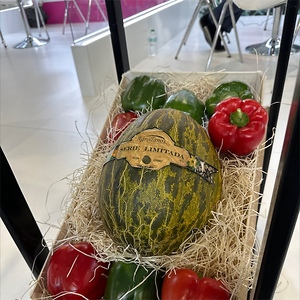

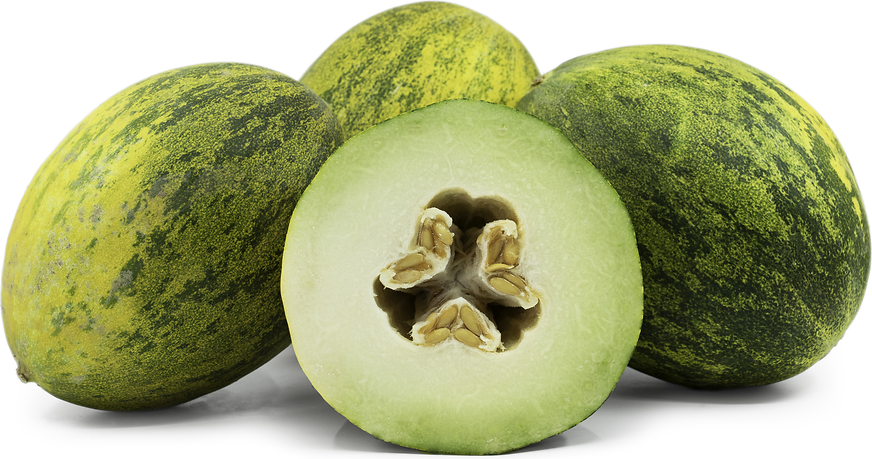
Santa Claus Melons
Estimated Inventory, 18 lbs : 0
Description/Taste
Santa Claus melons are small to medium fruits, averaging 20 to 30 centimeters in length, and have an oval to ovoid shape with curved, tapered ends. The melon’s rind is thick, hard, wrinkled, and rough, covered in textured striping and mottling. When the melons are young, the rind is a mixture of pale and dark green striping, sometimes flushed with yellow accents, and as the fruit ripens, the rind transforms into a bright yellow hue. The rind is also occasionally marked with sugar scars, an indication that the fruit has a high sugar content. Underneath the surface, the flesh ranges in color from white, yellow to pale green and is smooth, aqueous, soft, and tender with a succulent consistency. There is also a central cavity filled with many flat and oval seeds encased in stringy, moist golden fibers. Santa Claus melons will not emit a strong aroma when whole due to their thick rind, but once sliced, the flesh’s sweet, fragrant scent will permeate the room. Santa Claus melons, when ripe, will feel heavy for their size, bear a bright yellow hue, and the blossom end will yield slightly under pressure. The flesh contains a mild, refreshing, and sugary-sweet flavor with a subtly earthy nuance.
Seasons/Availability
Santa Claus melons are grown in the northern hemisphere in the late spring through the fall, with a peak season in the summer. The melons are also produced in the southern hemisphere, shipping melons to northern hemisphere commercial markets during the winter.
Current Facts
Santa Claus melons, botanically classified as Cucumis melo var. inodorus, are a type of winter melon belonging to the Cucurbitaceae family. The wrinkled, striped melons mature in approximately 110 days after sowing and are known for their thick rind, allowing the melons to be stored for an extended period and shipped worldwide. Santa Claus melons are highly favored by melon enthusiasts for their sweet, juicy flesh and are a specialty melon primarily eaten fresh. In Spain, the variety is known as Piel de Sapo, translating to mean “toad skin,” a descriptor given for the melon’s textured surface. Santa Claus melons are also known as Christmas melons, as the fruits cultivated in South America arrive in markets throughout the northern hemisphere during the holiday season.
Nutritional Value
Santa Claus melons are an excellent source of vitamin C to strengthen the immune system, reduce inflammation, and protect the cells against free radical damage. The melons are also a source of potassium to balance fluid levels, calcium to develop bones and teeth, and iron to build the protein hemoglobin for oxygen transport through the bloodstream.
Applications
Santa Claus melons have a delicate, sweet flavor and fragrant flesh well suited for fresh preparations. The melons can be incorporated into any recipe calling for casaba or muskmelon and are popularly consumed straight, out of hand, or sprinkled with lemon or lime juice. The flesh can also be sliced for fruit salads, side salads, blended into smoothies, or cut and wrapped in cured meats as an appetizer. Santa Claus melons have a tender texture that can be incorporated into oatmeal, yogurt, and other breakfast bowls, chopped into salsa, or balled and mixed into ice cream. They can also be pureed and frozen into popsicles, blended into sorbet, or cubed for fruit punch or white wine beverages. In addition to slicing the flesh from the rind, the melons can be cut in half, the seeds removed, and then filled with salad, soup, or a dessert filling. Santa Claus melons pair well with cheeses such as goat, feta, and cabrales, cured meats including prosciutto and salami, Marcona almonds, red onions, tomatoes, citrus, cucumbers, and herbs such as mint, basil, and parsley. Whole, uncut Santa Claus melons should be ripened at room temperature, and depending on the degree of ripeness, the melons may take 4 to 6 weeks to mature. Once ripe, the melons can be kept in the refrigerator for up to one week. Sliced Santa Claus melons will keep 3 to 5 days in a sealed container or wrapped in plastic. It is important to note that the sliced melon’s fragrance will be powerful with the ability to permeate other food items stored in the fridge.
Ethnic/Cultural Info
In Spain, Santa Claus melons are considered a specialty of La Mancha, a region that encompasses the provinces of Toledo, Ciudad Real, Albacete, and Cuenca. The region is famous for its rustic, simple dishes and a healthy diet based on the surrounding available agriculture. Santa Claus melons are primarily consumed fresh in La Mancha and are served sliced as a refreshing dessert. The melons are sometimes utilized in a twist on gazpacho and serve as a reprieve on hot summer days. Historically, Santa Claus melons were stored in cellars throughout the La Mancha region and were wrapped in paper for extended storage. On special occasions and holidays, the melons were brought out from the cellar, sliced, and traditionally wrapped in dry-cured ham, a dish known as jamón serrano, a favored Spanish appetizer.
Geography/History
Santa Claus melons are a type of casaba melon that is native to Turkey. Casaba melons have been growing wild since ancient times and were eventually spread to Europe, where they were extensively planted and cultivated in Spain. Santa Claus melons arose from Spanish growers and are primarily grown in the regions of Murcia and La Mancha in Spain. Today Santa Claus melons thrive in warm, sunny climates and are grown in the Middle East, Europe, South America, and in California and Arizona of the United States. When in season, the melons are sold through local fresh markets, farmer’s markets, and specialty distributors.
Recipe Ideas
Recipes that include Santa Claus Melons. One



